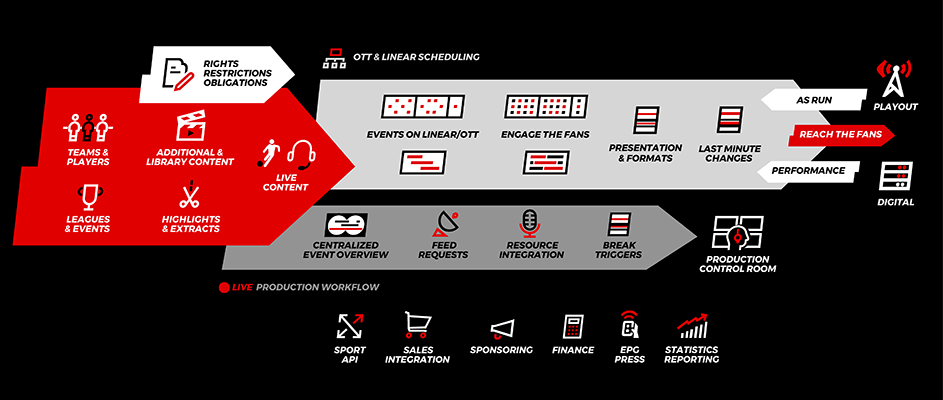Sports & Esports Module
Cooperation with such international sports broadcasters has inspired MEDIAGENIX to develop a Sports & eSports module that boosts operational efficiency and helps to get the best value out of expensive sports rights. The solution drastically reduces manual input and gives broadcasters the instant information they need to make strategic editorial and scheduling decisions.
HOW IT WORKS
With the sports & eSports module you can manage sport events in a structure. Football matches, for instance can be structured in seasons, and seasons in leagues.
You can link content to these leagues, seasons and events. A football game, for instance, can have the live game, press releases, highlights, and the teams linked to it. This means that in WHATS’ON you can search for content based on the event.
You can distribute and schedule content over the various channels or services at your disposal, create as many distribution ‘channels’ as you require, and make the content available to the viewer with maximum flexibility.
WHATS’ON manages the schedules of individual channels, allowing you to define feed, commentary and resource requirements. OTT or linear networks can create a centralized production overview for all their live content, and define for each event various schedule scenarios and the corresponding production needs (e.g. commentators for the live event, analysts and presenters for the studio show(s), specified per territory and language). The individual local channels then choose a scenario (e.g. with or without a studio show before, during or after the event), select commentators, analysts and presenters or request others. These scenarios are centrally defined, managed and streamlined in WHATS’ON.
CENTRALLY MANAGED METADATA
With the Sports & eSports module, you manage event metadata in one central place. You can import metadata from online databases that keep their information up to date, such as Opta. All you need to do to is connect the online database to WHATS’ON via the Sports API. The changes and updates in these databases will ripple through to the transmissions.
CONTINUOUSLY UPDATED
In WHATS’ON you can indicate, for instance, that you have the rights to broadcast all world cup matches of the Belgian team. Although you don’t know beforehand whether Belgium will even make it to the knock-out phase, you can already create all the events, the products, the contracts and transmissions, with placeholders for the as yet unknown.
The advantage is that when Belgium does go through, the system will fill in the next events according as Belgium keeps winning. No need to alter the rights descriptions.
Each time it becomes clear which teams are going through, the online database pushes this information to WHATS’ON and it ripples down to the products, the transmissions and the contracts.
The titles of the products and the secondary events are updated based on team information, the location etc. Placeholders are used to set formulae for the calculation of the titles, example: [Season name]:[matchday]: [Team1] v [team2]. Similar placeholders are available for secondary event graphics.

RESTRICTIONS AND OBLIGATIONS
Scheduling will adjust to the restrictions and obligations entered in WHATS’ON. Restrictions (e.g. only broadcast the finals) make your schedule valid or invalid. An obligation can be, say, to broadcast sponsorship or to broadcast a specific match live. Obligations typically have a kind of a deadline. 10 days before the game, for instance, all kinds of flags pop up if you haven’t met the obligation yet.
Integration with source booking systems and MAMS
For a live transmission WHATS’ON will send a request for a feed to the source booking system, including a request for an audio feed for every commentary language and requests for graphics.
After getting the details of the feeds, WHATS’ON will forward these to the MAM system so the media file can be created for playout of repeats or for creation of highlights.
Prepared for any contingency
As last-minute changes are inherent in sports (rainouts, injury breaks, …) you can easily adapt your short-term schedules —even switch to an alternative schedule—and steer your play-out system accordingly. These last-minute changes are also pushed to the EPGs. For networks, triggers are sent from the central overview that adjust the various scenarios of the individual channels in a matter of seconds.
Inserting ads, promos and sponsorships
The seamless integration with the ATS or dynamic ad insertion system optimises commercial revenues. Promos and sponsorships are automatically scheduled.
Engaging the viewer everywhere
Live content can be combined with sport magazines and documentaries to further improve the viewer experience and keep subscribers on board for the long term. Content can be promoted on social networks and platforms with (deleted) extracts, exclusives interviews, highlights, behind-the-scenes clips and other additional content.
The bottom line of the WHATS’ON Sports and eSports module is that you only need to select the games you want to broadcast. WHATS’ON takes care of all the rest. Note that you can just as easily use the modules for other live events, such as elections, or a music festival.
Whatever the future holds
One thing is certain: the systems used will need have both the flexibility, openness and functional depth to cope with substantial and fast changes in rights management and monetization, technology, distribution and business models.